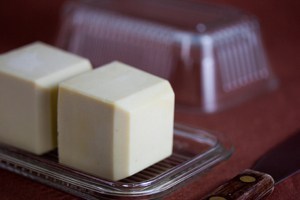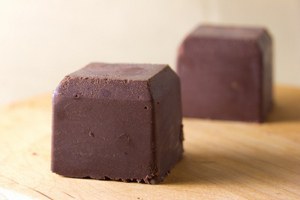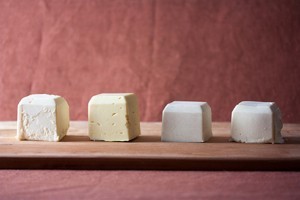Cultured European Style Vegan Butter
7
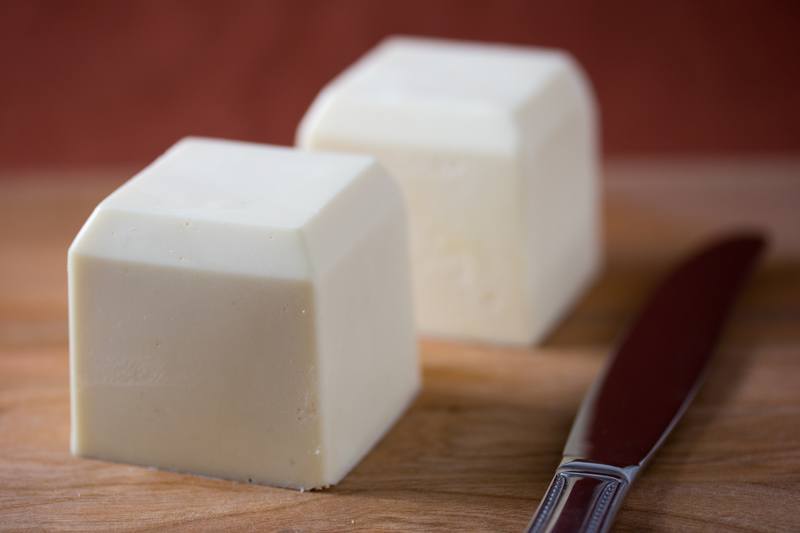
The more I learn about pastry, the more I realize that European pastry is on a completely different level compared to classic American pastry. My impression is that European pastry is all about introducing flavor depth through manipulating eggs, butter and technique. Croissants, strudel and danish pastries come to mind. American pastry, on the other hand, tends to build off bold flavors with a strong sugar backbone accentuated by spices. Apple pie, cupcakes and cookies come to mind here.
In the quest to become an adept baker, it’s important to draw from as many influences as possible. One trick that many American style bakers use to improve flavor depth is taking a cue from European bakers by using cultured European style butter.
How does American style butter differ from European style butter? Let’s take a look.
American Style Butter
American style butter has about 80 percent fat and is frequently pasteurized. Pasteurization wipes most of the naturally occurring microbes so the butter tastes clean. Most American cows are raised in factory farms and fed a diet of corn and soy so the butter is white and devoid of minerals also which accentuates this clean flavor.
European Style Butter
European style butter is about 82 to 86 percent fat and is developed more slowly which enables the cream to slightly ferment which allows the butter to develop a subtle sour tang. European cows are more likely to be grass fed which contributes carotenoids and minerals to the butter, contributing to a more rich flavor and yellow color. The slightly higher fat to water ratio compared to American style butter means that layered doughs will have a slightly lower tendency for gluten development and the fat will remain solid for a longer period which can be beneficial for layered doughs and short crusts.
The Components of Vegan Cultured European Style Vegan Butter
I set out to create a vegan European style butter so I could have other options when baking things like croissants and danishes. I wanted this vegan butter to be easy to make so other bakers could replicate it so I utilized plain non-dairy soy yogurt to make the water-based component. I then used slightly more fat than I normally do in Regular Vegan Butter to be true to style.
The Sad, Sorry State of Vegan Yogurts
Have you had vegan yogurt lately? If you haven’t tasted dairy yogurt in a while you may believe that it’s close to the quality of dairy yogurt and be content. It turns out that, in my opinion, vegan yogurt is in a very interesting place in the food world. Is it that vegan yogurt manufacturers don’t know any better or is it that most vegans keep buying lackluster yogurts to the point of where the vegan yogurt industry doesn’t feel compelled to change? It’s like the difference between Sunny D and fresh squeezed orange juice. Most vegan yogurts are just glorified starch slurries that have been hurried through any fermentation at all if they’re lucky. This made it tough to recommend a vegan yogurt for this vegan butter. I should mention that I do have a friend that is working to change the state of vegan yogurt in the form of a fermented coconut yogurt which I’m thrilled about.
Cultured butter utilizes slightly fermented cream so I would have to find a yogurt that had as complex of a flavor as possible. This automatically ruled out anything other than a couple soy yogurts. After reviewing vegan yogurts, I found that the yogurts with the most complex flavor available in the United States would be Wildwood Plain Soyogurt and Wholesoy Plain soy yogurt, in that order. I currently don’t recommend anything other than those two soy yogurts in the US. If you make your own vegan yogurt or know of a small producer who uses traditional methods to make a higher quality yogurt, then use that. If you’re thinking of using coconut or almond yogurt made by a major manufacturer, don’t waste your time and just make Regular Vegan Butter. Furthermore, if you’re interested in producing European style vegan butter as authentic as possible, I strongly advise you to not sacrifice that container of peach non-dairy yogurt you have in the back of your refrigerator; the sweetness alone will not make your vegan butter true to style.
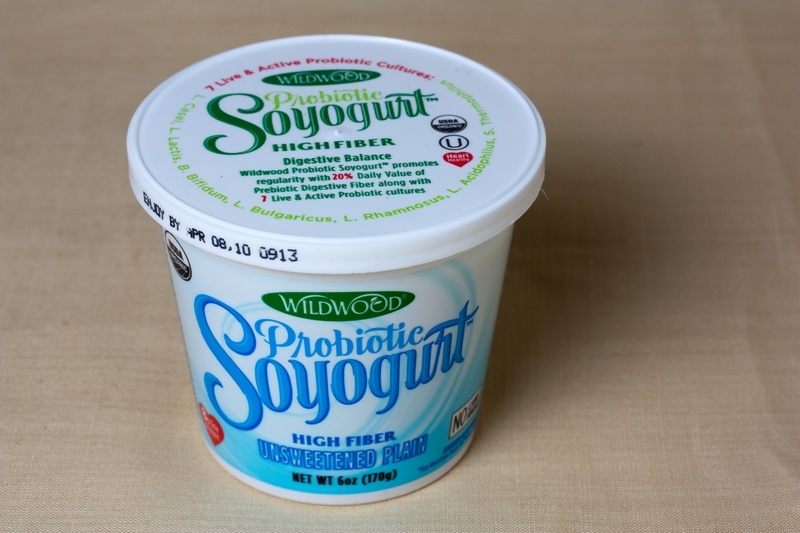

Combined with the slightly higher fat content and preferred soy yogurt, the vegan butter still didn’t have enough of the cultured flavor I was after so I included a small amount of apple cider vinegar to amplify it. Vegan yogurts are usually loaded with hydrocolloids so I was able to get away from using xanthan gum, but not lecithin. The lecithin will make your butter more plastic which means it will melt more uniformly without separating. This is especially important in layered pastry.
When making these vegan butters it's highly recommended that you use a silicone mold like the Tovolo King Cube Extra Large Silicone Ice Cube Tray. This will allow you to make gorgeous butter cubes that can easily be slid out of the molds.
When making these vegan butters it's highly recommended that you use a silicone mold like the Tovolo King Cube Extra Large Silicone Ice Cube Tray. This will allow you to make gorgeous butter cubes that can easily be slid out of the molds.
Learn more about the food science behind Vegan Butter.
Cultured European Style Vegan Butter Recipe
¼ cup + 1 teaspoon plain, non-dairy yogurt (unsweetened if possible and preferably soy)
½ teaspoon apple cider vinegar
¼ + ⅛ teaspoon salt
½ cup + 2 Tablespoons refined coconut oil, melted
2 Tablespoons + 1 teaspoon canola oil, light olive oil or rice bran oil
1) Curdle the yogurt
Add the non-dairy yogurt, apple cider vinegar and salt to the food processor. Process it for about 30 seconds and allow it to sit for a few minutes so the soy yogurt slightly curdles.
2) Mix the Vegan Butter ingredients
Melt the coconut oil in a microwave so it's barely melted and as close to room temperature as possible. Measure it and add it and the canola oil to the food processor. Making smooth vegan butter is dependent on the mixture solidifying as quickly as possible after it's mixed. This is why it's important to make sure your coconut oil is as close to room temperature as possible before you mix it with the rest of the ingredients.
3) Transfer the Vegan Butter to a mold so it solidifies
Add the lecithin and process for 2 minutes, scraping down the sides halfway through the duration. Pour the mixture into a mold and place it in the freezer to solidify. An ice cube mold works well. The vegan butter should be ready to use in about an hour. Store it in an airtight container in the refrigerator for up to 1 month or wrapped in plastic wrap in the freezer for up to 1 year. This recipe makes 1 cup (215 grams), or the equivalent of 2 sticks Cultured European Style Vegan Butter.



